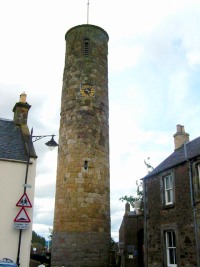|
|
Tours
Of Scotland, Abernethy

The
name Abernethy is an extremely potent name in Scottish history.
Here was an ancient Pictish capital, and then an ecclesiastical
metropolis of the Celtic Church of the Culdees, before St
Andrews, conveniently near to old Scone, the one-time Royal
centre of government only 8 miles away across the River
Tay, as the crow flies. Indeed even before that, Abernethy
was important, with a Pictish and also Roman fort, port and baths,
at Carpow
just to the north.
Now little more than a village, Abernethy stands at the foot of
its own steeply-climbing Ochils glen, right on the Fife border,
looking out across the level carse to the junction of Earn and
Tay rivers, just where the latter begins to widen to an estuary,
6 miles south-east of Perth. It is perhaps now most famous for
its Celtic Round Tower, one of the only two remaining in Scotland,
the second being at Brechin. These are tall, slender, tapering
columns, free-standing and not part of church buildings, although
sited in later kirkyards. The Abernethy Tower dates probably from
the 9th or 10th century, with 11th century alterations. It is
72 feet high and only 8 feet in interior diameter, with
walls 3 1/2 feet thick. There were six stages of timber flooring,
and door and windows are in the Irish style.
The
modern clock is somewhat incongruous. These towers served the
Celtic clergy as steeples, watch-towers against Viking invaders
and others, and refuges. There are still 76 of them standing in
Ireland.
With its Tower, Church and Churchyard, new Museum, winding Glen
walks, Mercat Cross and Traditional Houses, Abernethy village
has much to show the visitor, in addition to its resounding history,
although scarcely resounding perhaps was the sorry day when the
great King Malcolm Canmore did homage to William the Conqueror,
in 1072, at Abernethy, as evidently the only way to get the Norman
and his invading army to go home.
It
was Malcolm's English Queen Margaret, later sanctified by grateful
Rome, who instituted the pro-Romish movement in Scotland which
was to oust the Celtic Church not only from Abernethy but from
all the land.
Abernethy was made a burgh of barony in 1476, under the famous
Archibald Bell-the-Cat Douglas, Earl of Angus; and his present-day
descendant, the Duke of Hamilton, bears the style of Lord Abernethy
amongst his many subsidiary titles. The Douglases had inherited
Abernethy by marriage with the heiress of the MacDuff line of
Hereditary Abbots of Abernethy, who became secularised as the
de Abernethy family.
To
them, as the second main stem of the great MacDuff house, had
passed the right of crowning the Scots monarchs, after the end
of the senior stem, Earls of Fife, hence the Duke of Hamilton's
presenting to the present Queen her Scottish crown at St. Giles
Cathedral in 1953, at that significant ceremony.
About two miles east of the village, and actually over the Fife
border above Newburgh, are the remains of MacDuff's Cross, where
once all man-slayers to within the 9th degree of consanguinity
with the Earls of Fife or Lords Abernethy, could claim sanctuary
and gain remission of penalty other than the payment of a fixed
indemnity to the victim's family, a most useful inheritance in
otherwise lawless days.
To the other side of the village, high on a shoulder of Castle
Law hill to the south-west, is the site of a famous Scots hill-fort,
massively built of dry-stone walling with binding timber beaming,
a type of construction noted by Julius Caesar. These forts were
roughly contemporary with the Roman Invasions.
It
was in 80 AD that the celebrated Agricola " opened up new nations,
for the territory of tribes as far as the estuary named Tanous
( Tay ) was ravaged ", according to the Consul's son-in-law Tacitus.
The Carpow Roman fort's site, unlike the Pictish one, is on low
ground near the Tay. Nearby is Carpow House, and the scanty remains
of old Capow. Here was the ancient seat of the Lords of
Abernethy.
Abernethy is ideally located for easy trips to the St Andrews,
Dunfermline, Culross, Perth, Edinburgh, Falkland Palace,
and all of historic Fife and Perthshire.
|
|